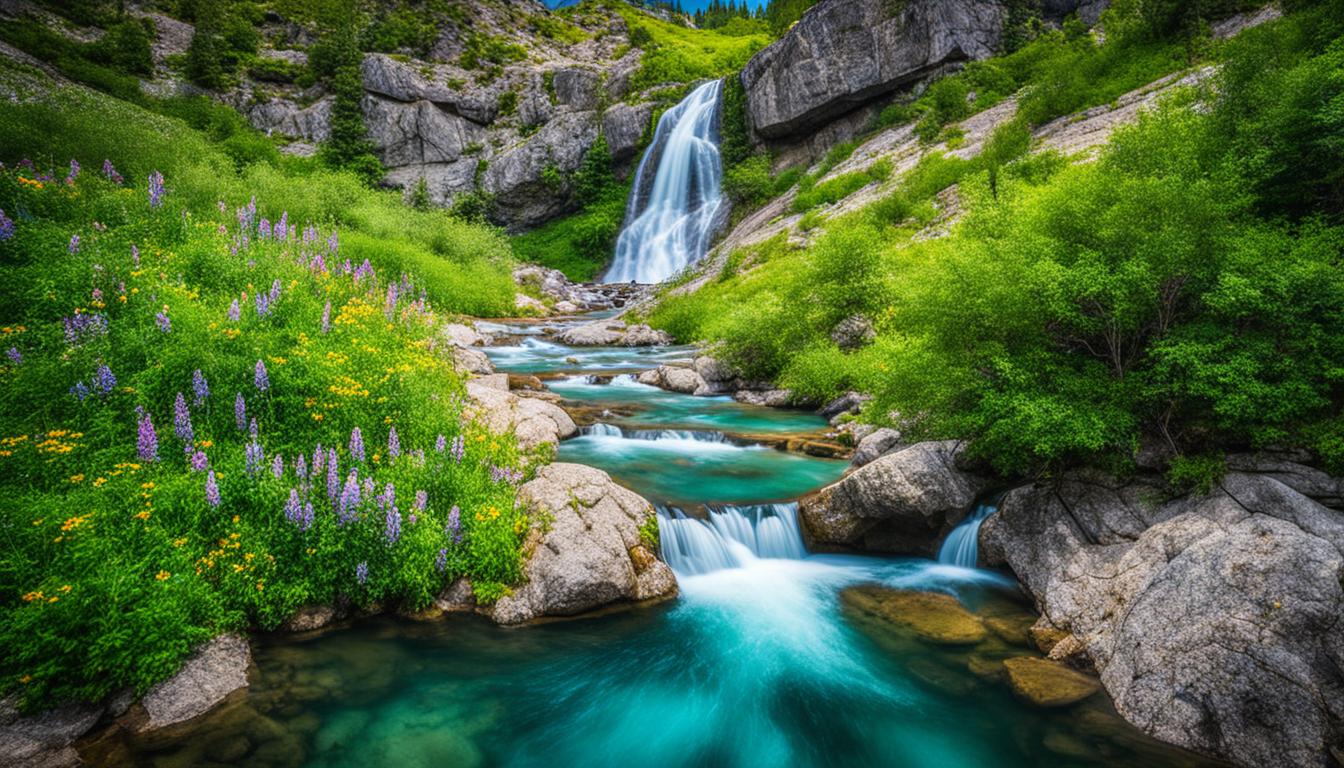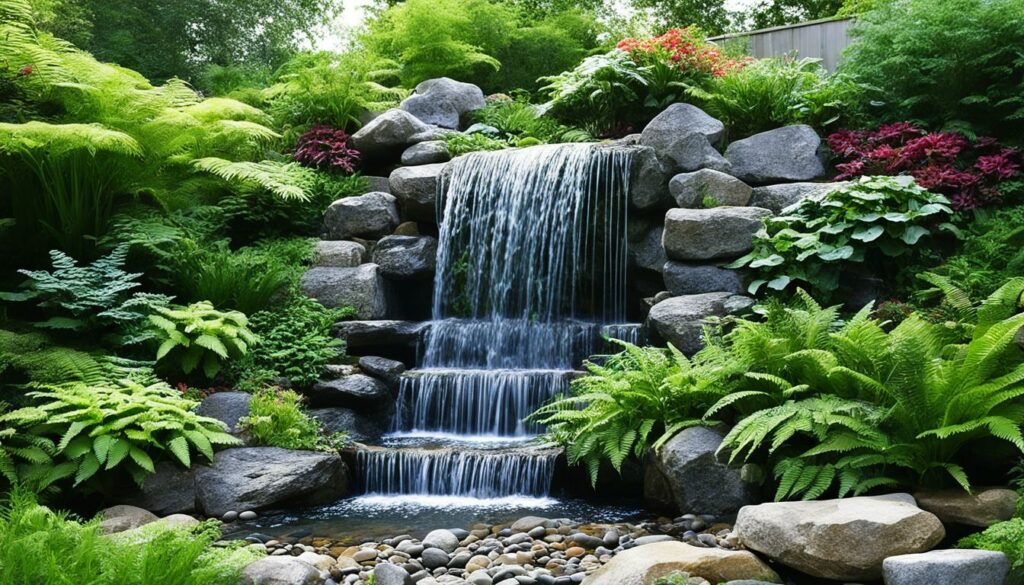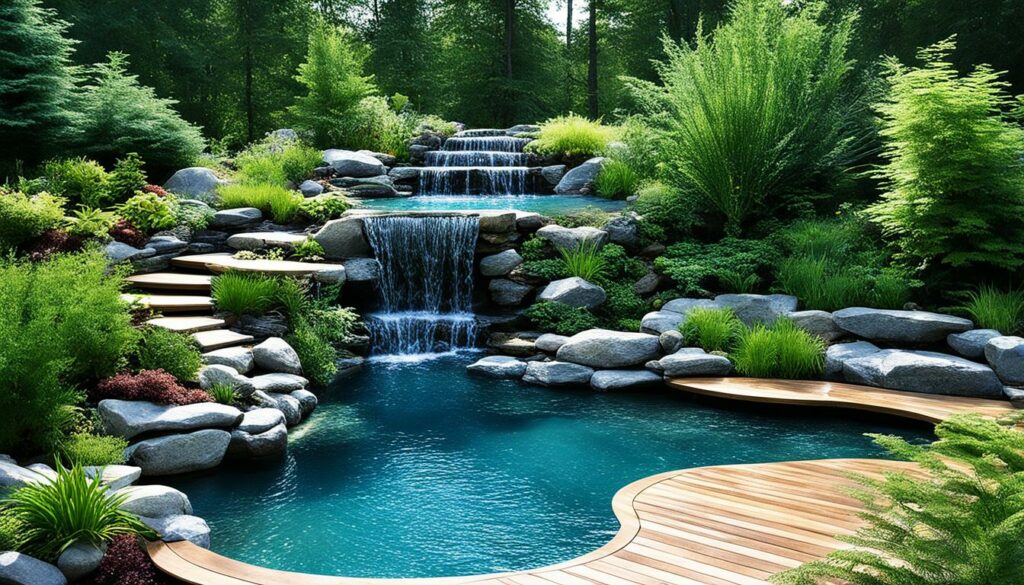
Transforming your garden with a natural-looking waterfall can add an element of tranquility and beauty. Crafting backyard waterfalls or landscape waterfalls requires detailed planning, selecting appropriate materials, and executing the design with precision. Start by gathering essential supplies like a pond liner, a powerful pump, and around 700 lbs. of varied stones to build your structure. Make sure the pump can generate at least 300 gallons per hour with a six-foot lift. For convenience, consider using a low-voltage pump with a separate transformer. A sand-based layout is crucial for a stable foundation, ensuring the resulting garden waterfalls blend seamlessly into your landscape.
Planning Your Garden Waterfall
Creating a serene garden waterfall begins with meticulous planning. This encompasses evaluating your garden landscape, visualizing the structure, and securing the necessary materials and tools.
Choosing the Location
When planning a garden waterfall design, the first step involves selecting an optimal location. Examine your property for existing slopes which can be ideal for a natural-looking waterfall structure. If your landscape lacks natural elevation, consider building up soil to create the desired effect. The goal is to seamlessly integrate the waterfall with your garden’s natural aesthetics.
Designing the Waterfall Structure
Next, focus on designing the natural-looking waterfall structure. Aim to replicate the spontaneity of nature by incorporating a variety of rock formations. Your waterfall construction plan should factor in both aesthetics and functionality. Draw inspiration from natural falls, emphasizing irregular edges and varying rock sizes to achieve a genuine appearance.

Gathering Materials and Tools
Finally, gather high-quality materials and tools essential to your waterfall construction plan. Select durable rocks that blend naturally into the landscape, an effective pond liner, and a reliable water pump to ensure continuous water circulation. Utilize a mix of rock sizes for a more organic look, and always secure a GFCI outlet for electrical safety.
Building the Waterfall Pool
Constructing the waterfall pool starts with meticulous planning and execution to ensure a durable and visually appealing feature in your garden. Let’s dive into the step-by-step process to achieve a perfect waterfall pool.
Excavating the Pond Area
Begin with pond excavation, carefully digging out an area that matches the size and shape of your planned pond. This stage sets the foundation for the entire waterfall pool construction and needs precision to avoid future complications. Make sure to use appropriate tools and machinery to achieve smooth and even edges in the excavated area.
Installing the Pond Liner
Once the excavation is complete, it’s time to install the pond liner. Place the liner carefully inside the pond area, ensuring there are no wrinkles or folds. This liner acts as a barrier to prevent water leakage. Gently press it against the pond walls and floor to create a snug fit. A high-quality rubber liner is recommended for its durability and flexibility.
Creating a Stable Base with Sand
Next, create a stable base with sand. Spread an even layer of sand across the bottom of the pond and use a trowel to smooth it out. This step is crucial as it provides a firm foundation for your waterfall pool construction and helps cushion the liner, preventing any punctures from sharp rocks or debris.
Incorporating a Submersible Pump
The final step in building your waterfall pool involves the installation of a submersible pump. This essential component recirculates water from the pond back to the top of the waterfall, ensuring a continuous and self-sustaining water flow. Position the pump discreetly at the bottom of the pond so it remains hidden while effectively managing water circulation.
Ensuring the pond is level and slightly elevated above ground level minimizes soil contamination and water loss. Follow these steps carefully for a well-constructed and efficient waterfall pool.

Constructing the Cascading Structure
Constructing a natural-looking cascading waterfall build in your garden revolves around meticulous rock selection and strategic positioning. The goal is to create a seamless flow of water that mimics nature’s handiwork. Here’s how to do it:
Selecting the Right Rocks
For a stunning waterfall, focus on rock selection for waterfalls that enhance the visual appeal and functionality. Larger, flat rocks should be chosen as they facilitate the cascading waterfall build, providing stability and beauty. Ensure each rock complements the natural water flow direction you aim to achieve.
Positioning the Spillway Rocks
Positioning the spillway rocks correctly is essential to guide the water cleanly into the receiving pool below. Select rocks with sharp, flat edges for the spillway to direct the water effectively, minimizing any loss. These rocks play a crucial role in the overall structure and visual spectacle of your garden waterfall.
Ensuring Water Flow and Direction
A vital aspect of the cascading waterfall build is ensuring the natural water flow direction. By carefully positioning the rocks and hiding the pump’s tubing within the structure, you preserve the aesthetic while maintaining efficient water circulation. This balance is key to creating a functional and beautiful garden feature that mirrors the elegance of a natural waterfall.
Tips for Creating Natural-Looking Waterfalls
Crafting a garden waterfall that mimics nature involves a blend of strategic planning and artistry. Here are some essential tips to help you achieve a stunning, natural appearance.
Using Varied Rock Sizes
An essential aspect of creating natural-looking waterfalls tips is to use a rock size variety in waterfalls. Mixing different rock sizes adds depth and prevents the waterfall from seeming too artificial. Large boulders can serve as focal points, while smaller stones fill gaps and enhance the overall texture.
Implementing Frame and Weir Stones
Proper use of frame and weir stones is crucial in waterfall construction. Frame stones form the sides and back, giving structure to the waterfall. Weir stones, placed horizontally, guide water to flow over them, creating a seamless water path. This technique is integral to achieving realistic and visually appealing water cascades.
Achieving a Natural Water Flow
A fundamental element in creating natural water flows is ensuring the water course is organic and meandering. By adjusting the orientation and placement of rocks, you can imitate the gentle curves and bends found in natural streams. This method encourages the water to follow a more natural and visually pleasing route.
Maintaining Proper Grade and Elevation
Another significant factor in constructing natural-looking waterfalls tips is maintaining the correct grade and elevation. Aim for a gradual rise, typically one foot in elevation for every ten feet of horizontal distance. This gentle slope helps prevent an abrupt drop, making the waterfall blend harmoniously with the garden landscape.
Conclusion
Bringing the essence of nature into your garden through natural waterfall construction can truly transform your outdoor sanctuary into a haven of peace and beauty. The journey of creating such a garden oasis begins with meticulous planning, from selecting the perfect location to designing a structure that seamlessly integrates with your landscape. Ensuring you gather the appropriate materials and tools is the foundation for a successful project.
The construction phase is crucial in achieving a natural-looking waterfall. Building a stable waterfall pool, incorporating a durable pond liner, and setting up a reliable submersible pump are essential steps. The careful selection and positioning of rocks create a realistic cascading effect, enhancing the waterfall’s aesthetic and functional appeal.
To elevate your garden with a tranquil water feature, it’s important to maintain the proper grade and elevation, ensuring a natural water flow. By using varied rock sizes and strategic placement of frame and weir stones, you can mimic the beauty of nature while enjoying the serene atmosphere a waterfall brings.
Embarking on the journey of natural waterfall construction is a rewarding endeavor that enhances your outdoor living space’s tranquility and charm. The serenity and joy derived from a personal waterfall can provide a lifetime of relaxation, transforming your garden into a true retreat.








